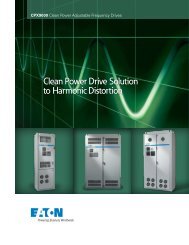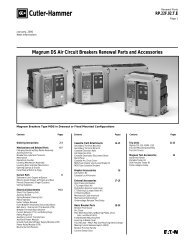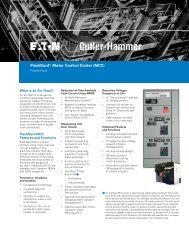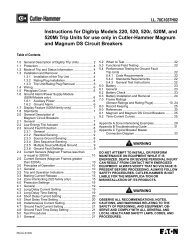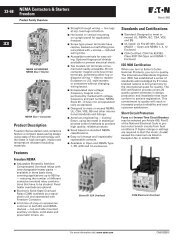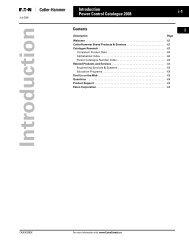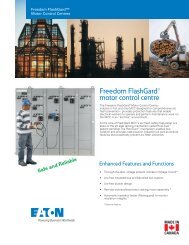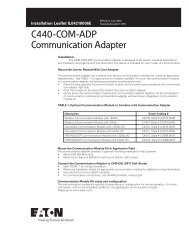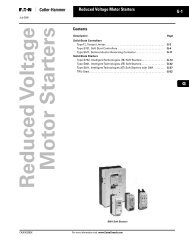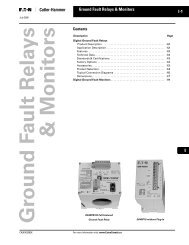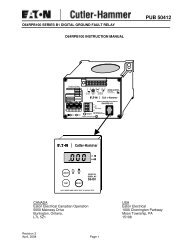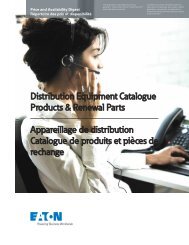Cutler-Hammer - Eaton Canada
Cutler-Hammer - Eaton Canada
Cutler-Hammer - Eaton Canada
Create successful ePaper yourself
Turn your PDF publications into a flip-book with our unique Google optimized e-Paper software.
B1-8<br />
Medium-Voltage Distribution Equipment<br />
Metal-Clad Switchgear – Drawout Vacuum Breakers (VCP-W)<br />
Application and Technical Data<br />
Control Equipment<br />
Circuit Breaker Control<br />
The VCP-W circuit breaker has a motor charged<br />
spring type stored energy closing mechanism.<br />
Closing the breaker charges accelerating<br />
springs. Protective relays or the control switch<br />
will energize a shunt trip coil to release the<br />
accelerating springs and open the breaker. This<br />
requires a reliable source of control power for<br />
the breaker to function as a protective device.<br />
For ac control, a capacitor trip device is used<br />
with each circuit breaker shunt trip to ensure<br />
that energy will be available for tripping during<br />
fault conditions. A control power transformer<br />
is required on the source side of each<br />
incoming line breaker. Closing bus tie or bus<br />
sectionalizing breakers will require automatic<br />
transfer of control power. This control power<br />
transformer may also supply other ac auxiliary<br />
power requirements for the switchgear.<br />
Signal: Initiation of<br />
Initiation of<br />
Close Signal<br />
Trip Signal<br />
VCP-W<br />
Circuit Breaker<br />
Main Contacts<br />
Breaker Aux.<br />
Switch<br />
"a" Contact<br />
Rated<br />
Control<br />
Voltage<br />
48 Vdc<br />
125 Vdc<br />
250 Vdc<br />
120 Vac<br />
240 Vac<br />
9.0<br />
4.0<br />
2.0<br />
4.0<br />
2.0<br />
C<br />
Closing Time<br />
∆t = 45-60 ms<br />
6<br />
6<br />
6<br />
6<br />
6<br />
∆t ±3 ms<br />
16<br />
7<br />
4<br />
6<br />
3<br />
200<br />
80<br />
40<br />
T<br />
Opening Time<br />
∆t = 30-45 ms<br />
Table 11: Control Power Transformers, 1 Phase, 60 Hertz➀➁<br />
Taps Secondary<br />
+7<br />
Volts<br />
1 ⁄2% Rated -71 ⁄2%<br />
2580<br />
2400<br />
2220<br />
240/120<br />
4470<br />
4160<br />
3850<br />
240/120<br />
5160<br />
4800<br />
4400<br />
240/120<br />
7740<br />
7200<br />
6680<br />
240/120<br />
9030<br />
8400<br />
7770<br />
240/120<br />
13405<br />
12470<br />
11535<br />
240/120<br />
14190<br />
13200<br />
12210<br />
240/120<br />
14835<br />
13800<br />
12765<br />
240/120<br />
24725<br />
23000<br />
21275<br />
240/120<br />
37088<br />
34500<br />
31913<br />
240/120<br />
38-56<br />
100-140<br />
200-280<br />
104-127<br />
208-254<br />
<strong>Cutler</strong>-<strong>Hammer</strong><br />
∆t ±3 ms<br />
28-56<br />
70-140<br />
140-280<br />
104-127<br />
208-254<br />
kVA kV<br />
Class<br />
5, 10, 15<br />
5, 10, 15<br />
5, 10, 15<br />
5, 10, 15<br />
5, 10, 15<br />
5, 10, 15<br />
5, 10, 15<br />
5, 10, 15<br />
5, 10, 15<br />
15, 25<br />
5<br />
5<br />
5<br />
15<br />
15<br />
15<br />
15<br />
15<br />
27<br />
38➂<br />
.035<br />
.035<br />
.035<br />
.035<br />
.035<br />
May 2001<br />
Dc control would require a dc control battery,<br />
Open<br />
battery charger and an ac auxiliary power<br />
source for the battery charger. The battery provides<br />
a very reliable dc control source, since it<br />
is isolated from the ac power system by the<br />
battery charger. However, the battery will require<br />
periodic routine maintenance and battery<br />
capacity is reduced by low ambient temperature.<br />
Breaker Aux.<br />
Switch<br />
"b" Contact<br />
"b" Breaks 6 ms<br />
Before "a" Makes<br />
∆t –6 ms<br />
to –3 ms<br />
"a" Breaks 7 ms<br />
Before "b" Makes<br />
Closed<br />
∆t +10 ms<br />
to +4 ms Open<br />
Any economic comparison of ac and dc con-<br />
Table 9: Auxiliary Switch Contacts Interrupting Capacities<br />
trol for switchgear should consider that the ac Type Auxiliary Switch Continuous Control Circuit Voltage<br />
capacitor trip is a static device with negligible<br />
maintenance and long life, while the dc bat-<br />
Current<br />
Amperes<br />
120 Ac 240 Ac 48 Dc 125 Dc 250 Dc<br />
tery will require maintenance and replace-<br />
Non-inductive circuit interrupting capacity in amperes<br />
ment at some time in the future.<br />
Breaker Auxiliary Switch 20<br />
15<br />
10<br />
16<br />
10<br />
5<br />
TOC<br />
20<br />
15<br />
10<br />
16<br />
10<br />
5<br />
Relays<br />
MOC Auxiliary Switch 20<br />
15<br />
10<br />
16<br />
10<br />
5<br />
Microprocessor-based or solid-state relays<br />
Inductive circuit interrupting capacity in amperes<br />
would generally require dc power or reliable<br />
uninterruptible ac supply for their logic circuits.<br />
Breaker Auxiliary Switch<br />
TOC<br />
20<br />
20<br />
15<br />
15<br />
10<br />
10<br />
16<br />
16<br />
10<br />
10<br />
5<br />
5<br />
Auxiliary Switches<br />
MOC Auxiliary Switch 20<br />
15<br />
10<br />
16<br />
10<br />
5<br />
Optional circuit breaker and cell auxiliary<br />
switches are available where needed for<br />
interlocking or control of auxiliary devices.<br />
Typical applications and operation are<br />
described in Tables 8 and 9.<br />
Table 10: VCP-W Breaker Stored Energy Mechanism Control Power Requirements<br />
Spring Charge Motor UV Trip Voltage Range Ind.<br />
Run Time Close or Trip<br />
mA (Max.)<br />
Close Trip<br />
Light<br />
Amperes Seconds Amperes<br />
Amperes<br />
Auxiliary switch contacts from the circuit<br />
breaker mechanism are limited in number by<br />
the breaker control requirements usually to<br />
one “a” and two “b” contacts for ac control or<br />
two “a” and two “b” contacts for dc control.<br />
When additional auxiliary contacts are needed,<br />
the optional auxiliary relay or mechanism<br />
operated cell (MOC) switch is used. Two<br />
types of MOC switches are available:<br />
a. operates with breaker in connected<br />
position only.<br />
b. operates with breaker in connected<br />
➀ Line-to-line connection only available.<br />
➁ Refer to <strong>Cutler</strong>-<strong>Hammer</strong> for other voltages and<br />
kVA ratings.<br />
➂ 150 kV BIL.<br />
position and test position.<br />
The optional truck operated cell (TOC) switch<br />
operates when the circuit breaker is levered<br />
into or out of the operating position.<br />
MOC and TOC switch contacts are not field<br />
convertible from “a” to “b” or “b” to “a”. Up<br />
to 3 MOC switches, each with 5a and 4b contacts,<br />
and 1 TOC with 4a and 5b contacts can<br />
Table 8: Breaker Auxiliary Switch Operating Times<br />
be provided in each breaker compartment.<br />
Auxiliary switch contacts are primarily used<br />
to provide interlocking in control circuits,<br />
switch indicating lights, auxiliary relays or<br />
other small loads. Suitability for switching<br />
remote auxiliary devices, such as motor heaters<br />
or solenoids, may be checked with the<br />
interrupting capacity listed in Table 9. Where<br />
higher interrupting capacities are required,<br />
Closed<br />
Open<br />
Closed



